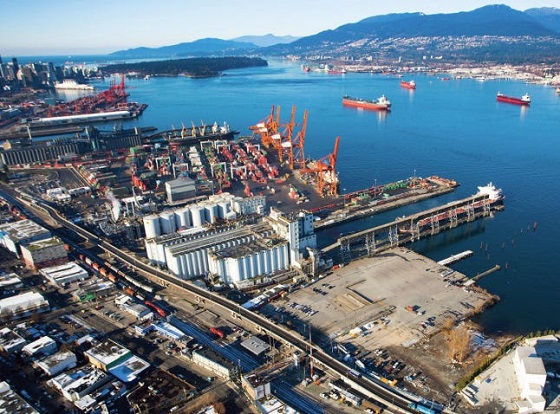Alberta
Orange Shirt Day – Acknowledging the Lasting Legacy of the Canadian Residential School System

The year 2020 marks the 24th anniversary of the final closure of the last operating Canadian residential school, located in Punnichy, Saskatchewan, in the year 1996.
Originally established in the late 1800’s, more than 130 residential schools operated across Canada for over 120 years. During this time, more than 150,000 First Nations, Metis and Inuit children were forcibly removed from their homes and placed into the schools (1).
Jointly operated by the Government of Canada and religious organizations across the nation, the residential school system was a violent and corrupt approach towards the total assimilation of Indigenous children and the ultimate erasure of Indigenous culture. The methods used by the schools to pursue this goal, as officially documented by the Canadian Truth and Reconciliation Commission (CTRC), were abhorrent acts of violence and humiliation against children that would raise a legacy of trauma and pain spanning generations.
The exact number of children who died during their time at the residential schools remains unclear, but is estimated to be greater than 6000 (2). The CRTC documents that many students succumbed to disease and malnourishment exacerbated by abysmal living conditions, while others died as a result of abuse and experimentation. Records show many children perished in fires when a number of schools burned down over the years, and others died by suicide, or while trying to escape (3).
“Children were abused, physically and sexually, and they died in numbers that would not have been tolerated in any school system in the country, or in the world.” – Summary of the Final Report of the Truth and Reconciliation Commission of Canada (4)
Since the final closure of the residential schools in 1996, steps towards national reconciliation – such as the launch of the Canadian Truth and Reconciliation Commission in 2008 – have been based in the acknowledgement and commemoration of the painful legacy of the schools across Canada. The documentation, preservation and dissemination of the residential school experience as told by the survivors is essential to understanding and accepting the implications of this dark and extensive period in Canadian history.
Among many ongoing discussions and dedications to the survivors and victims of the Canadian residential Schools, Orange Shirt Day is an annual recognition of the ongoing pursuit of reconciliation and affirmation in Canada.

Orange Shirt Day was born in Williams Lake, BC in May 2013 as a legacy of the St. Joseph Residential School Commemoration Project and Reunion. The project was founded by former student Esketemc (Alkali Lake) Chief Fred Robbins in an effort to bring together those whose lives had been negatively impacted by the schools. Specifically, “Events were designed to commemorate the residential school experience, to witness and honor the healing journey of the survivors and their families, and to commit to the ongoing process of reconciliation” (5).
Orange Shirt Day was founded as a result of the St. Joseph project, when former student and spokesperson for the Reunion group, Phyllis (Jack) Webstad, shared the experience of her first day at the residential school, “when her shiny new orange shirt, bought by her grandmother, was taken from her as a six-year old girl” (6).
September 30th was chosen as the annual Orange Shirt Day to coincide with the returning school year, and to commemorate the time of year in which children were originally taken from their homes to attend the residential schools.

On September 30, 2019, The National Centre for Truth and Reconciliation (NCTR) hosted a ceremony in honor of Orange Shirt Day at the Canadian Museum of History in Gatineau, Quebec. A list commemorating the names of 2,800 Indigenous children who died while attending the residential schools was presented on a 50-metre-long-ceremonial cloth. This ceremony represented an important first step, according to the NCTR, however, there is still a long way to go towards the proper recognition and memorialization of all who were lost to the schools.
Since 2013, Orange Shirt Day has continued to foster ongoing investigation and dialogue surrounding the history and lasting legacy of the residential school system within the Canadian historical landscape. It is a public call to listen, share, and remember those who suffered and now carry the lasting wounds of the government mandated Canadian residential school system, as well as those who never returned home at all.
For more stories, visit Todayville Calgary.
Alberta
Gondek’s exit as mayor marks a turning point for Calgary

This article supplied by Troy Media.
The mayor’s controversial term is over, but a divided conservative base may struggle to take the city in a new direction
Calgary’s mayoral election went to a recount. Independent candidate Jeromy Farkas won with 91,112 votes (26.1 per cent). Communities First candidate Sonya Sharp was a very close second with 90,496 votes (26 per cent) and controversial incumbent mayor Jyoti Gondek finished third with 71,502 votes (20.5 per cent).
Gondek’s embarrassing tenure as mayor is finally over.
Gondek’s list of political and economic failures in just a single four-year term could easily fill a few book chapters—and most likely will at some point. She declared a climate emergency on her first day as Calgary’s mayor that virtually no one in the city asked for. She supported a four per cent tax increase during the COVID-19 pandemic, when many individuals and families were struggling to make ends meet. She snubbed the Dec. 2023 menorah lighting during Hanukkah because speakers were going to voice support for Israel a mere two months after the country was attacked by the bloodthirsty terrorist organization Hamas. The
Calgary Party even accused her last month of spending over $112,000 in taxpayers’ money for an “image makeover and brand redevelopment” that could have benefited her re-election campaign.
How did Gondek get elected mayor of Calgary with 176,344 votes in 2021, which is over 45 per cent of the electorate?
“Calgary may be a historically right-of-centre city,” I wrote in a recent National Post column, “but it’s experienced some unusual voting behaviour when it comes to mayoral elections. Its last three mayors, Dave Bronconnier, Naheed Nenshi and Gondek, have all been Liberal or left-leaning. There have also been an assortment of other Liberal mayors in recent decades like Al Duerr and, before he had a political epiphany, Ralph Klein.”
In fairness, many Canadians used to support the concept of balancing their votes in federal, provincial and municipal politics. I knew of some colleagues, friends and family members, including my father, who used to vote for the federal Liberals and Ontario PCs. There were a couple who supported the federal PCs and Ontario Liberals in several instances. In the case of one of my late
grandfathers, he gave a stray vote for Brian Mulroney’s federal PCs, the NDP and even its predecessor, the Co-operative Commonwealth Federation.
That’s not the case any longer. The more typical voting pattern in modern Canada is one of ideological consistency. Conservatives vote for Conservative candidates, Liberals vote for Liberal candidates, and so forth. There are some rare exceptions in municipal politics, such as the late Toronto mayor Rob Ford’s populistconservative agenda winning over a very Liberal city in 2010. It doesn’t happen very often these days, however.
I’ve always been a proponent of ideological consistency. It’s a more logical way of voting instead of throwing away one vote (so to speak) for some perceived model of political balance. There will always be people who straddle the political fence and vote for different parties and candidates during an election. That’s their right in a democratic society, but it often creates a type of ideological inconsistency that doesn’t benefit voters, parties or the political process in general.
Calgary goes against the grain in municipal politics. The city’s political dynamics are very different today due to migration, immigration and the like. Support for fiscal and social conservatism may still exist in Alberta, but the urban-rural split has become more profound and meaningful than the historic left-right divide. This makes the task of winning Calgary in elections more difficult for today’s provincial and federal Conservatives, as well as right-leaning mayoral candidates.
That’s what we witnessed during the Oct. 20 municipal election. Some Calgary Conservatives believed that Farkas was a more progressive-oriented conservative or centrist with a less fiscally conservative plan and outlook for the city. They viewed Sharp, the leader of a right-leaning municipal party founded last December, as a small “c” conservative and much closer to their ideology. Conversely, some Calgary Conservatives felt that Farkas, and not Sharp, would be a better Conservative option for mayor because he seemed less ideological in his outlook.
When you put it all together, Conservatives in what used to be one of the most right-leaning cities in a historically right-leaning province couldn’t decide who was the best political option available to replace the left-wing incumbent mayor. Time will tell if they chose wisely.
Fortunately, the razor-thin vote split didn’t save Gondek’s political hide. Maybe ideological consistency will finally win the day in Calgary municipal politics once the recount has ended and the city’s next mayor has been certified.
Michael Taube is a political commentator, Troy Media syndicated columnist and former speechwriter for Prime Minister Stephen Harper. He holds a master’s degree in comparative politics from the London School of Economics, lending academic rigour to his political insights.
Troy Media empowers Canadian community news outlets by providing independent, insightful analysis and commentary. Our mission is to support local media in helping Canadians stay informed and engaged by delivering reliable content that strengthens community connections and deepens understanding across the country
Alberta
From Underdog to Top Broodmare

WATCH From Underdog to Top Broodmare (video)
Executive Producers Jeff Robillard (Horse Racing Alberta) and Mike Little (Shinelight Entertainment)
What began as an underdog story became a legacy of excellence. Crackers Hot Shot didn’t just race — she paved the way for future generations, and in doing so became one of the most influential producers the province has known.
The extraordinary journey of Crackers Hot Shot — once overlooked, now revered — stands as one of Alberta’s finest success stories in harness racing and breeding.
Born in humble circumstances and initially considered rough around the edges, Crackers Hot Shot overcame long odds to carve out a career that would forever impact the province’s racing industry. From a “wild, unhandled filly” to Alberta’s “Horse of the Year” in 2013, to producing foals who carry her spirit and fortitude into future generations.
Her influence ripples through Alberta’s racing and breeding landscape: from how young stock are prepared, to the aspirations of local breeders who now look to “the mare that did it” as proof that world-class talent can emerge from Alberta’s paddocks.
“Crackers Hot Shot, she had a tough start. She wasn’t much to look at when we first got her” — Rod Starkewski
“Crackers Hot Shot was left on her own – Carl Archibald heard us talking, he said ‘I’ll go get her – I live by there’. I think it took him 3 days to dig her out of the snow. She was completely wild – then we just started working on her. She really needed some humans to work with her – and get to know that people are not scary.” — Jackie Starkewski
“Crackers Hot Shot would be one of the top broodmares in Albeta percentage wise if nothing else. Her foals hit the track – they’re looking for the winners circle every time.” — Connie Kolthammer
Visit thehorses.com to learn more about Alberta’s Horse Racing industry.
-

 Crime2 days ago
Crime2 days agoCanada Seizes 4,300 Litres of Chinese Drug Precursors Amid Trump’s Tariff Pressure Over Fentanyl Flows
-

 Alberta1 day ago
Alberta1 day agoFrom Underdog to Top Broodmare
-

 Alberta2 days ago
Alberta2 days agoHow one major media torqued its coverage – in the take no prisoners words of a former Alberta premier
-

 Alberta2 days ago
Alberta2 days agoProvince orders School Boards to gather data on class sizes and complexity by Nov 24
-

 Business1 day ago
Business1 day agoCanada’s economic performance cratered after Ottawa pivoted to the ‘green’ economy
-

 Opinion2 days ago
Opinion2 days agoBill Gates Shakes Up the Climate Discussion
-

 Business2 days ago
Business2 days ago“We have a deal”: Trump, Xi strike breakthrough on trade and fentanyl
-

 Business1 day ago
Business1 day agoCanadians paid $90 billion in government debt interest in 2024/25




